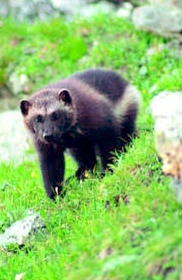What does the wolverine have to do with climate change? No, the X-men haven’t decided to #ActOnClimate (yet), but the two are very much related. Wolverines are mammals that live in snowy terrain of the mountain West, and they are currently threatened by climate change, at least according to some scientists. But if you ask the decision makers at the Fish and Wildlife Service (FWS), you might get a different story.
The wolverine is threatened by climate change

The North American Wolverine faces threats from climate change due its mountain west habitat, but the FWS recently withdrew plans to protect the species under the Endangered Species Act. Photo: FWS
The odd-looking and elusive wolverine, a large member of the weasel family, gained the attention of biologists when its numbers started dwindling in the early 1900s due to trapping and poisoning. Their numbers have since rebounded, with some 250-300 estimated to live in the contiguous US today. But now the species faces a new threat: climate change. Snow cover predictions show that the wolverine may lose habitat in a warming world. Based on this evidence, the FWS issued a proposal to list the wolverine as threatened in February 2013.
The proposed rule was peer-reviewed by seven external experts, the majority of whom agreed that the wolverine listing was warranted. In April 2014, the FWS convened a wolverine science panel composed of nine additional external experts. All nine panel members “expressed pessimism for the long-term future of wolverines in the contiguous US because of the effects of climate change on habitat.”
FWS steps back from a threatened species listing
Then in a reversal of the proposal, FWS announced this month that it would not move forward with the listing, citing that “the effects of climate change are not likely to place the wolverine in danger of extinction now or in the foreseeable future.”
So what changed? Strong scientific evidence was documented, internal and external scientists agreed; yet the agency changed its mind. As of now there is little that provides us insight into why the agency appears to have gone against the science in this case. Two internal FWS memos, posted by the Center for Biological Diversity, suggest that leadership went against the opinions of their own biologists, who recommended the species listing. The Center for Biological Diversity and the Government Accountability Project’s Climate Science Watch both posted analyses of the events with some ideas on FWS motivation.
One possible motivation is state interests overpowering the decision. The wolverine’s current range includes Idaho, Montana, Oregon, Washington, and Wyoming and some states weren’t happy about the potential listing. Idaho, Montana, Utah, and Wyoming have all filed public comments in opposition to the listing with Montana especially concerned about its planned trapping season.
A history of politics trumping science for the wolverine and the sage grouse
One place we can look for clues for the motivation of the FWS’ decision is the history of listings for the wolverine and other species with politically charged listing decisions.
The wolverine listing has seen science ignored before. In 2003, the FWS found there was “not substantial scientific information” to warrant protection for the species, but in 2006 a U.S. District Judge in Montana ruled that the agency ignored “substantial scientific information that would lead a reasonable person to conclude” that the wolverine warrants protection. Yet, the agency continued through 2008 to find that the science did not support a listing. It was only in 2013 that the agency acknowledged the need for protection and made the wolverine listing decision a priority.

Like the wolverine, the sage grouse continues to face political pressure from states not to be listed as threatened under the Endangered Species Act. Photo: FWS
The wolverine debate can be likened to that of the sage grouse—another threatened species whose habitat covers several western states (who also stand in opposition to a listing). The FWS has a court-ordered deadline to make a listing decision by the end of 2015 and the decision has been a controversial one thus far. Some claim influence from oil and gas interests and others argue that the science isn’t strong enough.
But the sage grouse also has a history of politics trumping science. In 2004, the New York Times reported that then-Deputy Assistant Secretary Julie MacDonald, a political appointee, was involved in editing the scientific content of a report justifying the listing of the Greater sage grouse in order to make the science appear less certain. In 2006, McDonald again interfered with FWS’ plan to list the Gunnison sage-grouse as endangered. After receiving three telephone calls concerning the proposed listing, including one from the governor of Colorado, MacDonald delayed the proposed listing by questioning the science behind the listing and later by removing the scientific details supporting the rule. Based on the edited report, and contrary to the recommendations of FWS biologists, sage grouse experts, and field staff, FWS Headquarters decided not to list the species.
The wolverine and the sage grouse: Protection or politicization?
In the case of both the wolverine and the sage grouse, the stakes are high. Economic activity in multiple states will be affected by potential listings. Will the science be brushed aside in favor of political or economic interests? For now we only have the trailer; I’ll be waiting for the feature film.
